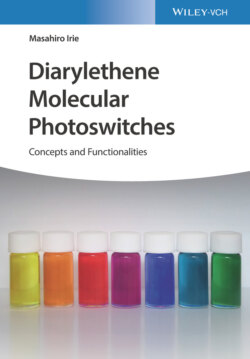Diarylethene Molecular Photoswitches

Реклама. ООО «ЛитРес», ИНН: 7719571260.
Оглавление
Masahiro Irie. Diarylethene Molecular Photoswitches
Table of Contents
List of Tables
List of Illustrations
Guide
Pages
Diarylethene Molecular Photoswitches. Concepts and Functionalities
Preface
1 Introduction. 1.1 General Introduction
1.2 Discovery of Diarylethene Molecular Photoswitches
References
2.1 Basic Concepts
2.2 Theoretical Study
2.3.1 Cyclization Reaction
2.3.2 Cycloreversion Reaction
References
3 Photoswitching Performance. 3.1 Quantum Yield
3.1.1 Photocyclization Quantum Yield
3.1.2 Solvent Effect on Cyclization Quantum Yield
3.1.3 Photocycloreversion Quantum Yield
3.2 Thermal Stability
3.3 Fatigue Resistance
3.4 Fluorescence Property
3.4.1 Turn‐Off Mode Photoswitching
3.4.2 Turn‐On Mode Photoswitching
3.5 Chiral Property
References
4 Photoswitchable Crystals
4.1 Dichroism
4.2 X‐Ray Crystallographic Analysis
4.3 Quantum Yield
4.4 Multicolored Systems and Nano‐Layered Periodic Structures
4.5 Fluorescent Crystals
4.6 Photomechanical Response
4.6.1 Surface Morphology Change
4.6.2 Reversible Shape Change
4.6.3 Bending Response of Mixed Crystals
References
5 Memory
5.1 Single‐Molecule Memory
5.2 Near‐Field Optical Memory
5.3 Three‐Dimensional Optical Memory
5.4 Readout Using Infrared Absorption, Raman Scattering, and Refractive Index Changes
References
6 Switches
6.1 Single‐Molecule Conductance Photoswitch
6.2 Optical Switch Based on Refractive Index Change
6.3 Magnetism
References
7 Surface Properties. 7.1 Surface Wettability
7.2 Selective Metal Deposition
7.3 Subwavelength Nanopatterning
References
8.1 Polymers
8.2 Liquid Crystals
References
9 Applications. 9.1 Organic Field‐Effect Transistors (OFETs)
9.2 Metal Organic Frameworks (MOFs)
9.3 Super‐Resolution Fluorescence Microscopy
9.3.1 Control of Cycloreversion Quantum Yield
9.3.2 Fatigue Resistance
9.3.3 Photoswitching with Single‐Wavelength Visible Light
9.3.4 Super‐Resolution Bioimaging
9.4 Chemical Reactivity Control
9.5 Biological Activity
9.6 Color Dosimeters
References
Appendix A Synthesis Procedures of Typical Diarylethenes
A.1 1,2‐Bis(2,4‐dimethyl‐5‐phenyl‐3‐thienyl)perfluorocyclopentene (7) [5–7]
2,4‐Dimethyl‐3,5‐dibromothiophene (3)
2,4‐Dimethyl‐3‐bromo‐5‐phenylthiophene (5)
1,2‐Bis(2,4‐dimethyl‐5‐phenyl‐3‐thienyl)perfluorocyclopentene (7)
A.2 1,2‐Bis(2‐ethyl‐6‐phenyl‐1‐benzothiophene‐1,1‐ dioxide‐3‐yl)‐perfluorocyclopenetene (11) [8–10]
1,2‐Bis(2‐ethyl‐1‐benzothiophen‐3‐yl)perfluorocyclopentene (9)
1,2‐Bis(2‐ethyl‐6‐iodo‐1‐benzothiophene‐1,1‐dioxide‐ 3‐yl)perfluorocyclopentene (10)
1,2‐Bis(2‐ethyl‐6‐phenyl‐1‐benzothiophene‐1,1‐dioxide‐3‐yl) perfluorocyclopenetene (11)
References
Index. a
b
c
d
e
f
g
h
i
k
l
m
n
o
p
r
s
t
u
v
w
x
y
z
WILEY END USER LICENSE AGREEMENT
Отрывок из книги
Masahiro Irie
Digital cameras take photos by using physical phenomena of inorganic materials. Photodiodes, such as CCD (charge‐coupled device) and CMOS (complementary metal oxide semiconductor), detect photons based on photovoltaic effects and construct photo‐images. Animals and plants have no such inorganic semiconductors. In biological systems, molecular photoswitches are extensively employed in photoreceptors. Vision, for example, uses the cis‐to‐trans photoisomerization of retinal to control the conformation of rhodopsin and initiate the transduction cascade to generate neural signals, while phototaxis of Chlamydomonas is activated by the trans‐to‐cis photoisomerization of retinal in the channel rhodopsin. In plants, the photoisomerization of phytochromes plays a key role in controlling their biological activity. These ingenious uses of organic molecules for the detection of photons in biological systems indicate that molecular photoswitches have the potential to be applied in the construction of various types of photon‐working reagents and devices.
.....
Digital on/off photoswitching between two discrete states was confirmed by measuring the switching response at a single‐molecule level. Figure 1.8c shows the fluorescence photoswitching of a single molecule of derivative 8 upon alternate irradiation with UV and visible light. Upon irradiation with UV light, the fluorescence abruptly switches from the off‐state to the on‐state, while upon irradiation with visible light the on‐state abruptly returns to the off‐state. The digital photoswitching response definitely indicates that diarylethene photoswitch 8 has bistable states. The photoisomerization between two discrete isomer states expressed by the two chemical structures is experimentally evidenced.
Figure 2.7 Schematic representation of the structures of S0 (orange) and S1 (green) potential energy surfaces corresponding to the photoisomerization between open‐ and closed‐ring isomers of a diarylethene. Reaction coordinate is the distance between the two reactive carbon atoms.
.....